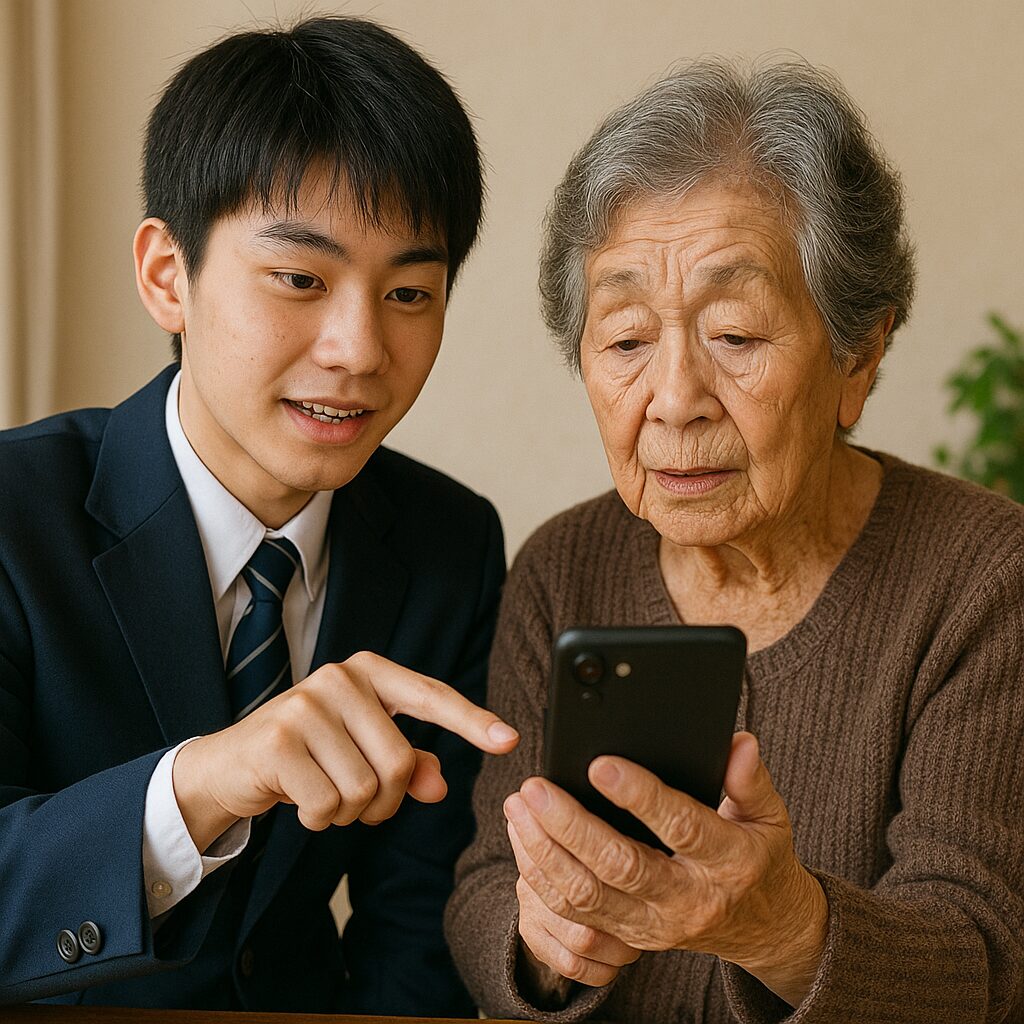“Rent-a-High Schooler” in Japan

“Rent-a-High Schooler” in Japan
“Rent-a-High Schooler” Program in Japan:
How Students Are Transforming Elderly Care One Visit at a Time
In Japan, a phrase has recently taken social media by storm: “レンタル高校生 (Rentaru Kōkōsei)” — literally, “Rent-a-High Schooler.” or “Rent-a-senior-high school student” At first glance, the term may sound provocative or puzzling, but the reality behind it is heartwarming and inspiring. It represents a unique initiative where high school students actively engage in helping elderly residents in their local communities.
Let’s take a closer look at what this project really is, why it’s gaining attention, and what it reveals about Japanese society — particularly its aging population and the evolving role of youth.
🎓 What Is the “Rent-a-High Schooler” Program?
The “Rent-a-High Schooler” initiative is a community service project organized by Ueda Chikuma High School in Nagano Prefecture, Japan. Students enrolled in the school’s social welfare department volunteer their time to visit elderly individuals living nearby, helping them with everyday tasks that have become challenging due to age or isolation.
But this isn’t just a casual volunteer activity — it’s part of their school curriculum. Students apply their classroom knowledge of caregiving and social welfare in real-world settings, fostering both empathy and responsibility.
👵 What Do the Students Actually Do?
 The activities vary widely depending on each senior citizen’s needs. Here are just a few examples:
The activities vary widely depending on each senior citizen’s needs. Here are just a few examples:
- 🌱 Weeding gardens and cleaning yards
- 🪟 Replacing paper in shoji (Japanese traditional sliding doors) or wiping windows
- 📱 Helping seniors operate smartphones and digital devices
- 🗣 Providing companionship and simply being someone to talk to
Many seniors request assistance not just for physical tasks, but emotional ones — especially conversation. Just having a young person around who listens and shows interest can dramatically brighten a day for someone who lives alone.
In return, students get to hear stories from the past, learn about local history and culture, and build confidence in communication and empathy. It’s a mutually enriching exchange.
📱 One Popular Role: Digital Tech Helper
One of the most appreciated tasks is helping the elderly learn how to use smartphones — something that’s easy to take for granted. Students teach seniors how to:
- Send and receive LINE messages (Japan’s most popular messaging app)
- Store and view photos of family and grandchildren
- Use video calls
- Manage calendar and medication reminders
For many seniors, these tasks were previously out of reach. With patient guidance, they gain a sense of digital inclusion — and independence.
📈 Why Did It Go Viral?
In May 2025, Japanese news outlets covered the project, and the term “Rent-a-High Schooler” began trending online. Part of its appeal lies in the name — it sounds similar to stylized Japanese service terms like “Rent-a-Girlfriend,” “Rental Ossan” (a “Rental Middle-Aged Man”), or “Rental Family,” which describe temporary role-based relationships in Japanese pop culture and sometimes even in real-life services. which describe temporary role-based relationships in pop culture and sometimes even in real-life Japan.
However, it’s important to note that while the phrase “Rent-a-High Schooler” follows that familiar, playful naming convention, the actual program is completely different in nature. This is not a commercial service, and no one is being “rented” in a transactional sense. Instead, it’s an educational, community-focused volunteer initiative built around mutual respect and social contribution.
Social media users responded with a mixture of amusement and admiration. Comments ranged from:
“What a funny name — but this is the kind of thing that gives me hope!”
“We need more of this kind of intergenerational support.”
“This should be a nationwide program.”
Students themselves began sharing their experiences online, sparking further interest and even inspiring other schools to consider similar initiatives.
🧓 The Deeper Issue: Japan’s Aging Population
To fully appreciate the significance of this project, one must understand a critical aspect of Japanese society: its rapidly aging population.
- Over 28% of Japan’s population is over 65
- Many seniors live alone in rural areas
- Public services are stretched thin, and loneliness is common
- The birth rate is declining, shrinking the youth population
This means there’s a growing need for local, flexible, human-centered support systems. The “Rent-a-High Schooler” project helps bridge that gap — not just by offering physical help, but by creating human connections where there often are none.
📚 An Educational Model with Real Impact
This project is also a showcase of practical education in action. Rather than limiting learning to textbooks, students are out in the field, practicing caregiving, communication, and community engagement.
They’re learning how to read between the lines of what people need, how to listen with empathy, and how to work with people from a different generation — skills that will serve them throughout life, no matter their career path.
Some students have even reported choosing nursing, social work, or public service careers as a result of their experience.
🌏 What’s Next? Growing the Movement
Because of its success, the program is drawing attention from other regions and schools. Here are some potential directions:
- 📍 Expansion to more schools across Japan
- 💻 Specialized digital-support teams for tech help
- 🏛 Collaboration with local governments and NGOs
- 📖 Integration into formal national education policy
- 🌐 Development of an online platform to match student volunteers with elderly requests
There’s even talk of involving private-sector companies to support the project through training, logistics, and outreach.
✅ Key Takeaways
- The “Rent-a-High Schooler” project connects high school students with elderly people in their communities.
- It provides real-world caregiving experience for students while addressing issues of senior isolation and support.
- The program has gone viral due to its heartwarming nature and unexpected name.
- It highlights Japan’s broader struggle with an aging society and declining youth population.
- This project could serve as a model for intergenerational care and community education globally.
🧠 In a time when technology often separates us, this program reminds us of the power of human connection — across generations, experiences, and needs.










